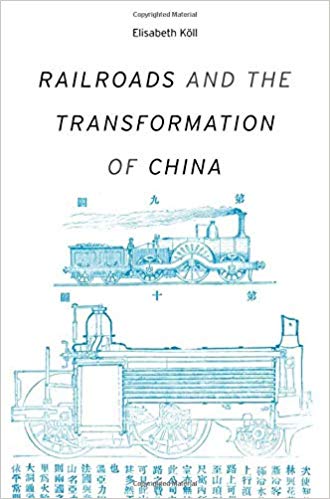
Review of Railroads and the Transformation of China by Elisabeth Köll. Harvard, 2019.
China’s soon to be 30,000-kilometer high speed rail network is rightly a point of pride for the country; indeed, the name of its newest line of passenger train, fuxing, speaks to Xi Jinping’s call for national “rejuvenation.” In a new book, Notre Dame history professor Elisabeth Köll examines the earliest history of China’s railroads.
The first tracks were laid during China’s semi-colonial era, with Western countries competing against each other to entrench their standards and languages. Leading Chinese recognized rail’s potential, most notably Sun Yatsen, who called railroads “an issue of life and death for China.” His vision for a national railway that would link Eurasia and Africa was as a forerunner of the Belt and Road Initiative.
An academic title, Köll’s focus is on on how China built the institutions that managed the tracks and makes use of a number of previously unused primary sources to highlight railroad operations. The book purposely ignores the railroad system Japan oversaw during its occupation of Manchuria.
The railroad’s development was delayed at first by a lack of human and financial capital and then later by the upheavals of war and revolution. Electrification did not take place until 1962, and only later did the railroad make a concerted push beyond the coastal cities. Due to China’s comparatively limited development, rail initially had the largest impact on agriculture, as opposed to accelerating industrialization as it had in the West. Because railroads would not assume liability for the freight it shipped, traders would literally send someone to sit on it to assure delivery.
Throughout China’s tumultuous 20th century, the railroad often served as the only regular source of national data. During the Great Leap Forward, Mao’s delusions were reinforced as he traveled in his private rail car by local officials who would literally transplant crops along the tracks to give the illusion of a productive harvest. Meanwhile, railroad accidents spiked 70%.
Engaging vignettes abound and the writing is often at its most inspired when Köll describes how the railroad captured the popular imagination as a symbol for modernity. Railroads transformed cities and work cultures, shifting them from seats of government bureaucracy to a more commercial orientation. Mixed cars also upended traditional gender interactions and were a source of literary inspiration. Images of train passengers and travelers helped sell everything from cigarettes to powdered milk. “Participation in rail travel came to represent participation in the bureaucratic, well-ordered, and above all modern urban life that the Chinese Republic sought to create in the years before 1937,” Köll writes.
Tourism, albeit expensive, was also accelerated by the railways: in the early twentieth century, a “one-way first-class ticket from Beijing to Shanghai amounted to approximately two-thirds of typical monthly expenses for a middle-class urban family.” The most striking example of “tourism,” was the youth who stormed the platforms during the Cultural Revolution to take advantage of free travel to important sites in CCP history.
While serious plans for high-speed rail were first put forward in the 1990s, construction was delayed in part because of a debate over technology. The debt and corruption that accompanied the expansion of China’s high-speed rail would lead to the Ministry of Railways’ abolishment in 2013. But the rails’ transformation of China continues: in 2017, there were more than three billion passenger rail journeys, 200 times the figure in 1915.
This version corrects an incorrect institutional affiliation for Elisabeth Köll from Purdue to Notre Dame.